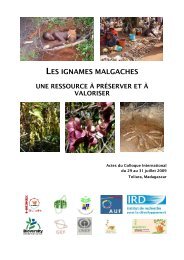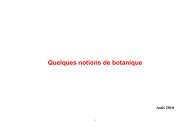brochure en pdf - formad-environnement
brochure en pdf - formad-environnement
brochure en pdf - formad-environnement
You also want an ePaper? Increase the reach of your titles
YUMPU automatically turns print PDFs into web optimized ePapers that Google loves.
indicated that it contained at least four homologous proteins, based on MS/MS peptide sequ<strong>en</strong>ce data. The protein is<br />
thermoresistant and remained active after 5 h heat treatm<strong>en</strong>t at 95 °C.<br />
Lalas S., Tsaknis J., Sflomos K. 2003. Characterisation of Moringa st<strong>en</strong>opetala seed oil variety<br />
‘Marigat’ from island Kokwa. European Journal of Lipid Sci<strong>en</strong>ce and Technology 105: 23–31.<br />
Makonn<strong>en</strong> E., Hunde A., Damecha G. 1997. Hypoglycaemic effect of Moringa st<strong>en</strong>opetala<br />
aqueous extract in rabbits. Phytotherapy Research 11(2): 147–148.<br />
Maundu P.M., Ngugi G.W., Kabuye C.H.S. 1999. Traditional food plants of K<strong>en</strong>ya. K<strong>en</strong>ya<br />
Resource C<strong>en</strong>tre for Indig<strong>en</strong>ous Knowledge (KENRIK), Nairobi, K<strong>en</strong>ya. 270 p.<br />
Mayer F.A., Stelz A. 1993. Moringa st<strong>en</strong>opetala provides food and low-cost water purification.<br />
Agroforestry Today 5(1): 16–18.<br />
Muluvi G.M., Spr<strong>en</strong>t J.I., Soranzi N., Provan J., Odee D., Folkard G., McNicol J.W., Powell<br />
W. 1999. Amplified fragm<strong>en</strong>t l<strong>en</strong>gth polymorphism (AFLP) analysis of g<strong>en</strong>etic variation in<br />
Moringa oleifera Lam. Molecular Ecology 8(3): 463–470.<br />
Munyanziza E. 2007. Moringa drouhardii Jum. Fiche de Protabase. van der Voss<strong>en</strong>, H.A.M. &<br />
Mkamilo, G.S. (Eds). PROTA (Plant Resources of Tropical Africa / Ressources végétales de<br />
l’Afrique tropicale), Wag<strong>en</strong>ing<strong>en</strong>, Pays Bas. http://database.prota.org/recherche.htm.<br />
Nadir Reyes Sanchez, S. Ledin and I. Ledin. 2006. Biomass production and chemical<br />
composition of Moringa oleifera under differ<strong>en</strong>t managem<strong>en</strong>t regimes in Nicaragua. Agroforestry<br />
Systems 66: 231-242.<br />
Abstract: The effects of differ<strong>en</strong>t planting d<strong>en</strong>sities (250,000, 500,000 and 750,000 plants ha1) and cutting frequ<strong>en</strong>cies<br />
(45, 60 and 75 days) on the biomass production and chemical composition of Moringa oleifera was studied in a<br />
completely randomised split plot design with four blocks, in Managua, Nicaragua, located geographically at 1208¢15¢¢<br />
N and 8609¢36¢¢ E. The 75 day cutting frequ<strong>en</strong>cy produced the highest fresh matter yield, 100.7 and 57.4 Mg ha1<br />
year1, and dry matter (DM) yield, 24.7 and 10.4 Mg ha1 year1, during the first and second year, respectively. All<br />
planting d<strong>en</strong>sities produced the highest DM yield at 75 day cutting frequ<strong>en</strong>cy. In the first year, the d<strong>en</strong>sity of 750,000<br />
plants ha1 produced the highest fresh matter yield, 88.0 Mg ha1 and highest DM yield, 18.9 Mg ha1, but in the second<br />
year the d<strong>en</strong>sity of 500,000 plants ha1 gave the highest yields, 46.2 Mg ha1 and 8.1 Mg ha1, respectively. During the<br />
first year, DM (22.8%), neutral deterg<strong>en</strong>t fibre (NDF) (30.8%) and ash (9.14%) cont<strong>en</strong>ts were highest and in vitro DM<br />
digestibility (IVDMD) (68.2%) was lowest in the longest cutting interval, while cont<strong>en</strong>ts of crude protein (CP) (22.8%)<br />
and acid deterg<strong>en</strong>t fibre (ADF) (22.8%) were not affected significantly by cutting frequ<strong>en</strong>cy. In the second year, DM<br />
and CP cont<strong>en</strong>ts and IVDMD were not significantly affected by cutting frequ<strong>en</strong>cy, whereas NDF, ADF and ash cont<strong>en</strong>ts<br />
were lowest in the 60 day cutting frequ<strong>en</strong>cy. Planting d<strong>en</strong>sity had no significant effect on chemical composition or<br />
IVDMD. These data suggest that Moringa forage could be an interesting protein supplem<strong>en</strong>t for ruminants.<br />
Olson M.E. 2001. Wood and bark anatomy in Moringa (Moringaceae). Haseltonia 8: 85-121.<br />
Olson M.E. 2002a. Interg<strong>en</strong>eric relationships within the Caricaceae-Moringaceae clade<br />
(Brassicales) and pot<strong>en</strong>tial morphological synapomorphies of the clade and its families. Int. J. Plant<br />
Sci. 163(1):51–65.<br />
Olson M.E. 2002b. Combining data from DNA sequ<strong>en</strong>ces and morphology for a phylog<strong>en</strong>y of<br />
Moringaceae (Brassicales). Systematic Botany 27(1): 55–73.<br />
Abstract :The Old World dry tropical family Moringaceae is remarkable for the great diversity of habit and floral<br />
morphology found within its only g<strong>en</strong>us, Moringa. To infer the phylog<strong>en</strong>etic relationships of all 13 species, parsimony<br />
analyses of morphological data and DNA sequ<strong>en</strong>ces from a low-copy nuclear region (PEPC), a chloroplast region<br />
(trnG), and a tandemly-repeated nuclear region pres<strong>en</strong>t in high copy number (ITS) were conducted of each data set<br />
separately and combined. Characters from studies of ontog<strong>en</strong>y substantially <strong>en</strong>hanced the resolution of the<br />
morphological data set. The Incongru<strong>en</strong>ce L<strong>en</strong>gth Differ<strong>en</strong>ce test indicated the congru<strong>en</strong>ce of all data sets, as did<br />
Templeton tests comparing the single tree resulting from the combined analysis in the context of the individual data<br />
sets. This tree is pres<strong>en</strong>ted as the preferred topology, in which the four bottle trees appear in a basal paraphyletic<br />
assemblage, with the three species of sl<strong>en</strong>der trees (including the economically important M. oleifera) forming a clade<br />
that is sister to a clade of the six species of tuberous shrubs and trees of northeast Africa. Moringa is curr<strong>en</strong>tly divided<br />
into three sections, but because of the basal grade, it cannot be divided into useful monophyletic infrag<strong>en</strong>eric taxa. The<br />
31





